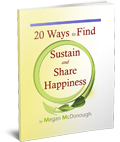The workshop leader was an accomplished yogi, usually very confident in his teaching skills. So why was he looking so uncomfortable in front of the group? His face was red as he repeated over and over again that he was very embarrassed.
The reason for his embarrassment? He was telling the group about his programs and his center. As he did his bit of self-promotion, he looked like a kid who just stole the cookie from the cookie jar—guilty and miserable.
Why is it that marketing and promotion can feel just plain slimy in the body/mind?
If it feels wrong, it is. But it is not the marketing that’s wrong, it’s the sequence.
Imagine this. You are walking down the hallway and BAM! you jump into triangle pose. Then you keep walking on your merry way down the hall for 10 more steps. BAM! You jump into warrior pose.
Striking a pose may work well for Madonna. For the rest of us mere mortals, people just look at you funny and maybe we feel a bit embarrassed.
There is a sequence to yoga. In training we spend quite a bit of time talking about how certain postures set the stage for a more difficult posture. You don’t, for example, open a class with a backbend. You work up to it.
Marketing has its own dance, its own rhythm, its own unfolding. There is a sequence to marketing. When done correctly, marketing and promotion feels like a true relationship rather than an awkward first kiss.
This speaker was striking a marketing pose BAM! right at the beginning of the workshop. It is no wonder he felt embarrassed. The marketing sequence was out of step.
There is a cure for the Embarrassed by Marketing Syndrome (EMS—yup, I think I just created a new acronym, not to be confused with the hiking store here in the Northeast).
The first step is being aware. When does marketing feel awkward? Are there moments when promotion is smooth (like when someone else is giving you a glowing testimonial)? What is your process for self-promotion in a workshop? Where is that promotion placed in the context of the workshop? How ready does your audience appear for more information about what you have to offer? What is your response to the embarrassment—keep pushing through it? Shut down? Disclose your embarrassment?
Just as in life, awareness of the issue is the first step in changing your promotional efforts to a more effective and less embarrassed strategy.
Once you become aware of yourself in relation to the marketing flow, and your natural tendency toward or against that flow, you can take the next step—deliberate action to make marketing less painful and more natural.
Here are some ways to easily and comfortably weave marketing into your program:
- Get started before the program even begins. If you have a list of registrants for the workshop, send them an e-mail or a letter with a brief note welcoming them to the group and letting them know you’re looking forward to working with them. Make sure to give them your contact information.
- Wait for the right time. Don’t start your program by talking about yourself, or your products or services. That’s like asking someone to marry you while you’re still on your first date. You need to create a relationship before you ask for more commitment.
- Make your handouts count. Give participants an easy, non-threatening way to stay in touch with you: make sure your handouts contain quality information that people will want to hang on to, and list your website and contact information at the bottom of the handouts so it’s right at their fingertips.
- Encourage ongoing communication. Don’t let your workshop or lecture turn into a one-shot deal. Include a tear-off coupon in your handouts so participants can sign up for your e-newsletter, and offer a gift for signing up, such as additional free content about your subject. Have them return the completed coupon to the resource table (see #7 below) so they can get another look at your products.
- Use your products within the workshop. For example, if you wrote a book, actually open the book and read a paragraph or two in relation to what you are teaching, or ask someone in the class to read it. That way people can see, hold, and touch the book to make it more tangible.
- Give away your product or service. Have fun contests, reward people who are actively participating, have a raffle winner pulled from the e-newsletter coupons, or give a prize to the person who traveled the farthest to come to the workshop. Do it in front of the group and have them hand your book (or DVD, CD, training manual, etc.) through the audience to the winner. Again, this makes it tangible.
- Have your product available in the room. Whether it is on display or for sale, make sure your participants can easily access it during the time with you. Before you take a break, invite people to check out the resource table. (This is where people will return the coupon for the e-newsletter registration, giving them a chance to linger.)
- Make the intangible tangible. If you do not have a product, but you want to promote a workshop or a service, use a tangible product to represent the intangible. If you are promoting a yoga retreat in Costa Rica, for example, display a beautiful picture book of the area along with brochures.
- Ask your host or an assistant to introduce you. Having others talk you up is much less awkward than self-promotion. Trouble is, many times we leave this to chance. Make sure you give your host or assistant a written introduction or bullet-point list of promotional references that they can use when making the introduction.
- Ask raving fans to chime in during the program. Sometimes those who love your work will contribute freely. You can also help elicit third-party testimonials with encouragement along the lines of, “Tell us how you have used this process in your work.” Their feedback will be helpful to other participants as well as to you.
- Use testimonials on all promotional material. Provide feedback surveys at the end of the training, offering people the option to include their names and check a statement giving you permission to use their comments in promotional material. Then post the nice things they said on your website, and include them in brochures or handouts for your next seminar.
- Stay in touch with attendees through your newsletter. Keep communication going for those who sign up for your e-newsletter, developing the relationship over time. If you don’t have a newsletter going already, just click here to see an example and get started.
Marketing doesn’t have to feel awkward or embarrassing, and you don’t have to play hardball from the get-go. Think of marketing as a story that gradually unfolds over the course of a relationship, reaping benefits for all involved.
__________________________________________________________________
Resource
Learn how to keep in constant contact with your clients (and potential clients) by sending consistent, ongoing emails. Click here to see how easy it is to send out professional looking emails on a small budget.



 Sign up and receive 20 Ways to Find, Sustain and Share Happiness along with ongoing tips for achieving personal and professional clarity.
Sign up and receive 20 Ways to Find, Sustain and Share Happiness along with ongoing tips for achieving personal and professional clarity.



